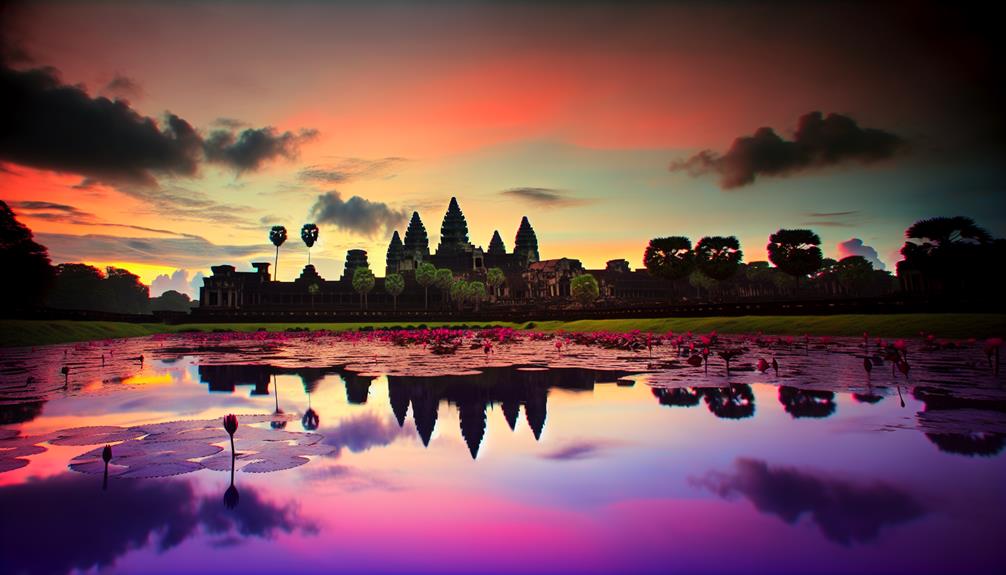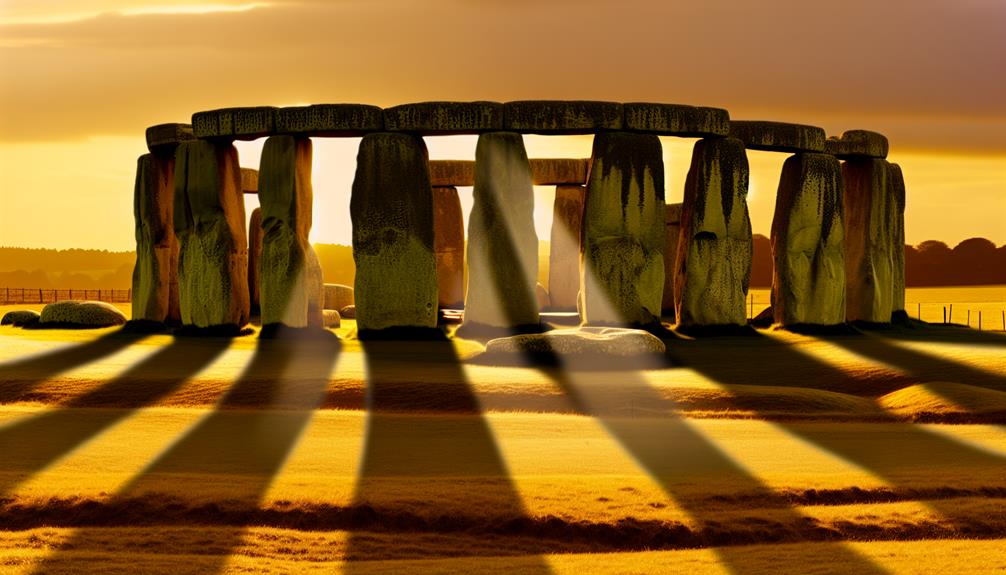Nestled amidst the lush Cambodian landscape, Angkor Wat stands as a beacon of ancient grandeur and architectural ingenuity. Its towering spires and intricate bas-reliefs whisper tales of a bygone era, inviting visitors to unravel the mysteries hidden within its sacred walls. As the sun sets over this majestic temple complex, one can't help but ponder the secrets it still holds and the countless souls who have been captivated by its beauty. But what lies beneath the surface of this awe-inspiring monument remains a tantalizing enigma, waiting to be discovered by those who dare to venture further.
Key Takeaways
- Immersion in ancient Khmer architecture and spirituality.
- UNESCO World Heritage site with rich cultural significance.
- Modest dressing and silence etiquette for temple visits.
- Local cuisine experience with dishes like Fish Amok.
- Preparation tips include water, sunscreen, and local guides.
History of Angkor Wat
Located in Cambodia, the history of Angkor Wat dates back to the early 12th century when it was built as a Hindu temple dedicated to the god Vishnu. The construction of Angkor Wat under the reign of King Suryavarman II holds immense historical significance as it represents the peak of the Khmer Empire's architectural and artistic achievements. The temple complex covers an area of over 400 acres and is a symbol of the might and grandeur of the empire during that era.
Over the years, Angkor Wat has been the subject of numerous archaeological discoveries that have shed light on the culture and religious practices of the Khmer civilization. Excavations around the temple have unearthed artifacts, inscriptions, and structures that have provided valuable insights into the daily life and beliefs of the people who inhabited the region centuries ago. These discoveries have helped historians and archaeologists piece together the puzzle of Angkor Wat's past and its role in the broader context of Cambodian history.
The historical significance of Angkor Wat extends beyond its initial purpose as a Hindu temple, as it later evolved into a Buddhist site. This transformation reflects the cultural and religious changes that took place in the region over the centuries. Overall, Angkor Wat stands as a demonstration of the rich history and heritage of Cambodia, attracting visitors from around the world to marvel at its architectural splendor and archaeological treasures.
Architectural Marvels
The intricate architectural design of Angkor Wat showcases a blend of unique Khmer aesthetics and engineering prowess, making it a remarkable demonstration of the ancient civilization's skill and creativity. The temple complex is renowned for its unique design, characterized by its five towers that represent the peaks of Mount Meru, the mythical home of the Hindu gods. The central tower rises to a height of 213 feet, symbolizing the center of the universe in Hindu cosmology.
One of the engineering marvels of Angkor Wat is its extensive use of sandstone blocks, meticulously carved and arranged to form intricate bas-reliefs and elaborate decorations. The precision with which these massive blocks were cut and positioned is a reflection of the advanced engineering techniques employed by the Khmer builders. The temple's symmetrical layout and precise orientation towards the cardinal points further highlight the meticulous planning and architectural ingenuity of its creators.
Moreover, the complex system of reservoirs, canals, and moats surrounding Angkor Wat demonstrates the Khmer's sophisticated understanding of hydraulics and water management. These engineering feats not only served practical purposes such as irrigation and flood control but also contributed to the overall aesthetic appeal of the temple complex.
Cultural Significance
The cultural significance of Angkor Wat extends beyond its architectural grandeur, encompassing a rich tapestry of historical, religious, and artistic influences that have shaped its enduring legacy. Angkor Wat, a UNESCO World Heritage site, holds profound importance in Cambodian culture due to its deep connections with traditional customs and religious practices.
Throughout history, Angkor Wat has served as a center of spiritual devotion, primarily dedicated to the Hindu god Vishnu and later evolving to Buddhist practices. This religious transformation reflects the cultural evolution of Cambodia and highlights the site's adaptability to changing beliefs over the centuries. The intricate carvings and bas-reliefs found within Angkor Wat depict scenes from Hindu epics like the Ramayana and Mahabharata, as well as Buddhist teachings, showcasing the fusion of both religious traditions in one architectural masterpiece.
Moreover, Angkor Wat's architectural layout, aligned with astronomical phenomena, emphasizes the significance of celestial bodies in traditional Khmer beliefs. The temple's orientation towards the west symbolizes the concept of death, aligning with traditional funeral customs observed in Cambodia. This integration of cosmic symbolism and traditional rituals demonstrates the interconnectedness of religious beliefs, architectural design, and cultural practices at Angkor Wat.
Myth and Legends
Embodying a domain where history intertwines with folklore, Angkor Wat's mythic tapestry weaves tales of divine beings and legendary quests, enriching its cultural landscape. The mythical origins of Angkor Wat are deeply rooted in Cambodian folklore, giving rise to a rich tapestry of legendary tales that have been passed down through generations. These myths not only provide insight into the beliefs and values of the ancient Khmer civilization but also add a layer of mystique to the temple complex.
- The Legend of Angkor Wat's Creation: According to local folklore, Angkor Wat was built in a single night by the gods using magic and divine intervention.
- The Tale of the Naga King: Legends speak of a powerful Naga king who resided in the waters surrounding Angkor Wat, symbolizing protection and prosperity.
- The Quest for the Sacred Relic: Mythical stories recount the epic journey undertaken by a Khmer prince to retrieve a sacred relic, culminating in the construction of Angkor Wat.
- The Curse of the Sleeping Guard: It is said that a curse befalls those who disturb the slumber of the stone guardians at Angkor Wat, invoking caution and respect from visitors.
These legendary narratives not only add a sense of wonder to Angkor Wat but also highlight the enduring cultural significance of this ancient marvel.
Restoration Efforts
Amidst the ongoing efforts to preserve Angkor Wat's architectural splendor and historical significance, meticulous restoration initiatives have been diligently undertaken by experts in the field of heritage conservation. The conservation challenges faced in maintaining a site as vast and complex as Angkor Wat are immense. Factors such as weathering, vegetation growth, and structural instability due to age all pose significant hurdles. To combat these challenges, dedicated teams work tirelessly to assess, document, and restore the ancient structures to their former glory.
Fundraising efforts play an important role in supporting the extensive restoration projects at Angkor Wat. Various organizations, both local and international, contribute funds to support the sustainability of these endeavors. These financial resources are essential for acquiring the necessary tools, materials, and expertise required for the intricate restoration work.
Historical preservation is at the core of Angkor Wat's restoration efforts. By meticulously documenting the original construction techniques and materials used by the Khmer builders, experts can authentically recreate and conserve the site's unique features. Community involvement is also crucial in ensuring the success of restoration projects. Engaging local residents in the preservation process fosters a sense of ownership and pride in Angkor Wat's heritage, creating a sustainable framework for continued conservation efforts.
Spiritual Symbolism
When investigating the spiritual significance of Angkor Wat, one explores the intricate symbolism woven throughout its architectural design and cultural heritage. The symbolic representations within Angkor Wat offer mystical interpretations that reflect the spiritual beliefs of the Khmer Empire.
Here are some key elements of spiritual symbolism found in Angkor Wat:
- Lotus Flowers: The lotus flower, a symbol of purity and enlightenment in Buddhism, is prominently featured in the design of Angkor Wat. It represents spiritual growth and the journey towards enlightenment.
- Naga Balustrades: The intricate carvings of serpents, known as Naga balustrades, symbolize protection and fertility in Hindu and Buddhist traditions. They guard the temple and are believed to ward off evil spirits.
- Five Towers: The five towers of Angkor Wat represent the peaks of Mount Meru, the mythical center of the universe in Hindu cosmology. Each tower symbolizes a different element – earth, water, fire, air, and wisdom – creating a sacred space aligned with cosmic principles.
- Bas-Reliefs: The bas-reliefs found on the walls of Angkor Wat depict scenes from Hindu epics like the Mahabharata and Ramayana. These intricate carvings serve as visual narratives of moral lessons and mythical tales, enriching the spiritual experience for visitors.
Through these symbolic representations and mystical interpretations, Angkor Wat stands as a reflection of the spiritual depth and cultural richness of the ancient civilizations that once thrived in Cambodia.
Visiting Angkor Wat
A visit to Angkor Wat offers an unparalleled opportunity to immerse oneself in the awe-inspiring grandeur of ancient Khmer architecture and spirituality. When visiting this UNESCO World Heritage site, it is essential to observe temple etiquette to respect the sacredness of the place. Visitors should dress modestly, covering their shoulders and knees, and remove hats and shoes before entering the temple complex. Silence is encouraged to maintain a peaceful atmosphere for meditation and reflection.
Exploring Angkor Wat can work up an appetite, and indulging in local cuisine is a delightful way to experience the culture of Cambodia. Nearby food stalls and restaurants offer an array of traditional dishes such as Fish Amok, a fragrant fish curry steamed in banana leaves, or Lok Lak, a flavorful stir-fried beef dish served with rice. Trying Khmer cuisine not only tantalizes the taste buds but also provides insight into the culinary heritage of the region.
As you navigate the vast temple complex, be sure to carry sufficient water and sunscreen, especially during the hot and humid months. Engaging with knowledgeable local guides can enhance your understanding of the history and significance of Angkor Wat. By respecting temple customs, savoring local delicacies, and being prepared for your visit, you can make the most of your experience at this extraordinary site.
Tips for Travelers
To guarantee a smooth and enjoyable visit to Angkor Wat, travelers should prioritize understanding the local customs and practical considerations before setting out on their journey. When visiting this magnificent UNESCO World Heritage site, here are some essential tips to enhance your experience:
- Respect Local Customs: Cambodian culture values modesty and respect. When exploring Angkor Wat, it is advisable to dress appropriately, covering shoulders and knees, to show respect to the sacred site and the local customs.
- Stay Hydrated: The Cambodian climate can be hot and humid, especially when exploring the temple complex. It is essential to carry an adequate amount of water to stay hydrated throughout the day.
- Beware of Scams: As a popular tourist destination, Angkor Wat can attract scammers. Be cautious of individuals offering tour guide services at exceptionally low prices or selling fake souvenirs.
- Sample Local Cuisine: Don't miss the opportunity to indulge in Cambodian cuisine. From delicious street food to traditional dishes, exploring the local food scene can be a delightful experience.
When capturing your memories through travel photography at Angkor Wat, remember to be respectful of the site and other visitors. By embracing these tips, travelers can make the most of their journey to Angkor Wat, creating lasting memories of this awe-inspiring destination.
Frequently Asked Questions
Are There Any Secret Chambers or Hidden Passages in Angkor Wat?
There have been persistent rumors and historical legends surrounding the existence of secret chambers and hidden passages in various ancient structures worldwide. Architectural mysteries often fuel speculation, prompting explorations and investigations to uncover these elusive features.
Such tales capture the imagination, adding an air of mystery and intrigue to these historical sites. The pursuit of uncovering these secrets continues to intrigue both scholars and the public alike.
What Is the Significance of the Carvings on the Walls?
The carvings on the walls hold profound symbolic meanings, serving as artistic expressions of the cultural and spiritual beliefs of the time.
These intricate depictions provide a window into the thoughts, values, and narratives that were significant to the society that created them.
Through a careful analysis of these carvings, one can uncover a rich tapestry of stories and ideas that illuminate the historical context and artistic prowess of the period.
Can Visitors Witness Any Traditional Ceremonies at Angkor Wat?
Visitors to various cultural sites around the world often seek the opportunity to witness traditional ceremonies and performances. These cultural rituals provide insight into the customs and beliefs of the local populations, allowing visitors to experience the rich tapestry of traditions that have been passed down through generations.
Witnessing these traditional performances can offer a deeper understanding of the cultural heritage of a region, enhancing the overall travel experience.
Are There Any Special Events or Festivals Held at Angkor Wat?
Special events and cultural festivals play a significant role in attracting visitors and fostering a sense of community. These gatherings serve as platforms for cultural exchanges, celebrations, and expressions of heritage.
They often showcase traditional practices, arts, and performances, creating unique experiences for participants. These events not only enrich local culture but also contribute to tourism and economic growth by drawing in diverse audiences and promoting the region's cultural identity.
Is There a Specific Dress Code for Visiting Angkor Wat?
When visiting cultural sites, it is crucial to adhere to dress etiquette to show respect for the cultural expectations of the local community. Following the appropriate dress code demonstrates an understanding and appreciation for the traditions and values of the place being visited.
Cultural expectations regarding attire can vary widely, so it is advisable to research and follow guidelines to guarantee a positive and respectful experience.
Conclusion
To sum up, Angkor Wat in Cambodia stands as a remarkable demonstration of the ancient Khmer Empire's architectural and spiritual achievements. With its rich history, intricate carvings, and cultural significance, this UNESCO World Heritage site continues to captivate visitors from around the world.
Exploring Angkor Wat is truly a journey back in time, where every stone tells a story and every carving holds a mystery waiting to be unraveled. As the saying goes, 'history comes alive' at Angkor Wat.


